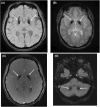Neuroimaging abnormalities associated with immunotherapy responsiveness in Down syndrome regression disorder
- PMID: 38375538
- PMCID: PMC11021615
- DOI: 10.1002/acn3.52023
Neuroimaging abnormalities associated with immunotherapy responsiveness in Down syndrome regression disorder
Abstract
Objective: To determine the prevalence of neuroimaging abnormalities in individuals with Down syndrome regression disorder (DSRD) and evaluate if neuroimaging abnormalities were predictive of therapeutic responses.
Methods: A multicenter, retrospective, case-control study which reviewed neuroimaging studies of individuals with DSRD and compared them to a control cohort of individuals with Down syndrome (DS) alone was performed. Individuals aged 10-30 years and meeting international consensus criteria for DSRD were included. The presence of T1, T2/FLAIR, and SWI signal abnormalities was reviewed. Response rates to various therapies, including immunotherapy, were evaluated in the presence of neuroimaging abnormalities.
Results: In total, 74 individuals (35%) had either T2/FLAIR and/or SWI signal abnormality compared to 14 individuals (12%) without DSRD (p < 0.001, 95%CI: 2.18-7.63). T2/FLAIR signal abnormalities were not appreciated more frequently in individuals with DSRD (14%, 30/210) than in the control cohort (9%, 11/119) (p = 0.18, OR: 1.63, 95%CI: 0.79-3.40). SWI signal abnormalities were appreciated at a higher frequency in individuals with DSRD (24%, 51/210) compared to the control cohort (4%, 5/119) (p < 0.001, OR: 7.31, 95%CI: 2.83-18.90). T2/FLAIR signal abnormalities were localized to the frontal (40%, 12/30) and parietal lobes (37%, 11/30). SWI signal abnormalities were predominantly in the bilateral basal ganglia (94%, 49/52). Individuals with DSRD and the presence of T2/FLAIR and/or SWI signal abnormalities were much more likely to respond to immunotherapy (p < 0.001, OR: 8.42. 95%CI: 3.78-18.76) and less likely to respond to benzodiazepines (p = 0.01, OR: 0.45, 95%CI: 0.25-0.83), antipsychotics (p < 0.001, OR: 0.28, 95%CI: 0.11-0.55), or electroconvulsive therapy (p < 0.001, OR: 0.12; 95%CI: 0.02-0.78) compared to individuals without these neuroimaging abnormalities.
Interpretation: This study indicates that in individuals diagnosed with DSRD, T2/FLAIR, and SWI signal abnormalities are more common than previously thought and predict response to immunotherapy.
© 2024 The Authors. Annals of Clinical and Translational Neurology published by Wiley Periodicals LLC on behalf of American Neurological Association.
Conflict of interest statement
Dr. Jonathan D. Santoro has received consulting funds from Cycle Pharma and UCB on topics relating to multiple sclerosis and myelin oligodendrocyte glycoprotein‐related disorder. Dr. Espinosa is the executive director of the Linda Crnic Institute for Down Syndrome at the University of Colorado which receives funds from the Global Down Syndrome Foundation.
Figures


References
-
- de Graaf G, Buckley F, Skotko BG. Estimates of the live births, natural losses, and elective terminations with Down syndrome in the United States. Am J Med Genet A. 2015;167:756‐767. - PubMed
-
- Worley G, Crissman BG, Cadogan E, Milleson C, Adkins DW, Kishnani PS. Down syndrome disintegrative disorder: new‐onset autistic regression, dementia, and insomnia in older children and adolescents with Down syndrome. J Child Neurol. 2015;30:1147‐1152. - PubMed
-
- Santoro SL, Baumer NT, Cornacchia M, et al. Unexplained regression in Down syndrome: management of 51 patients in an international patient database. Am J Med Genet A. 2022;188:3049‐3062. - PubMed
Publication types
MeSH terms
Grants and funding
LinkOut - more resources
Full Text Sources
Medical

